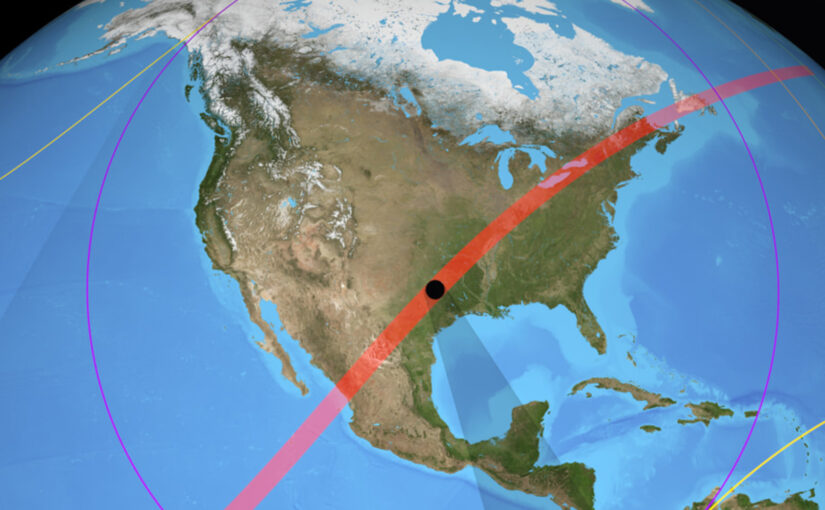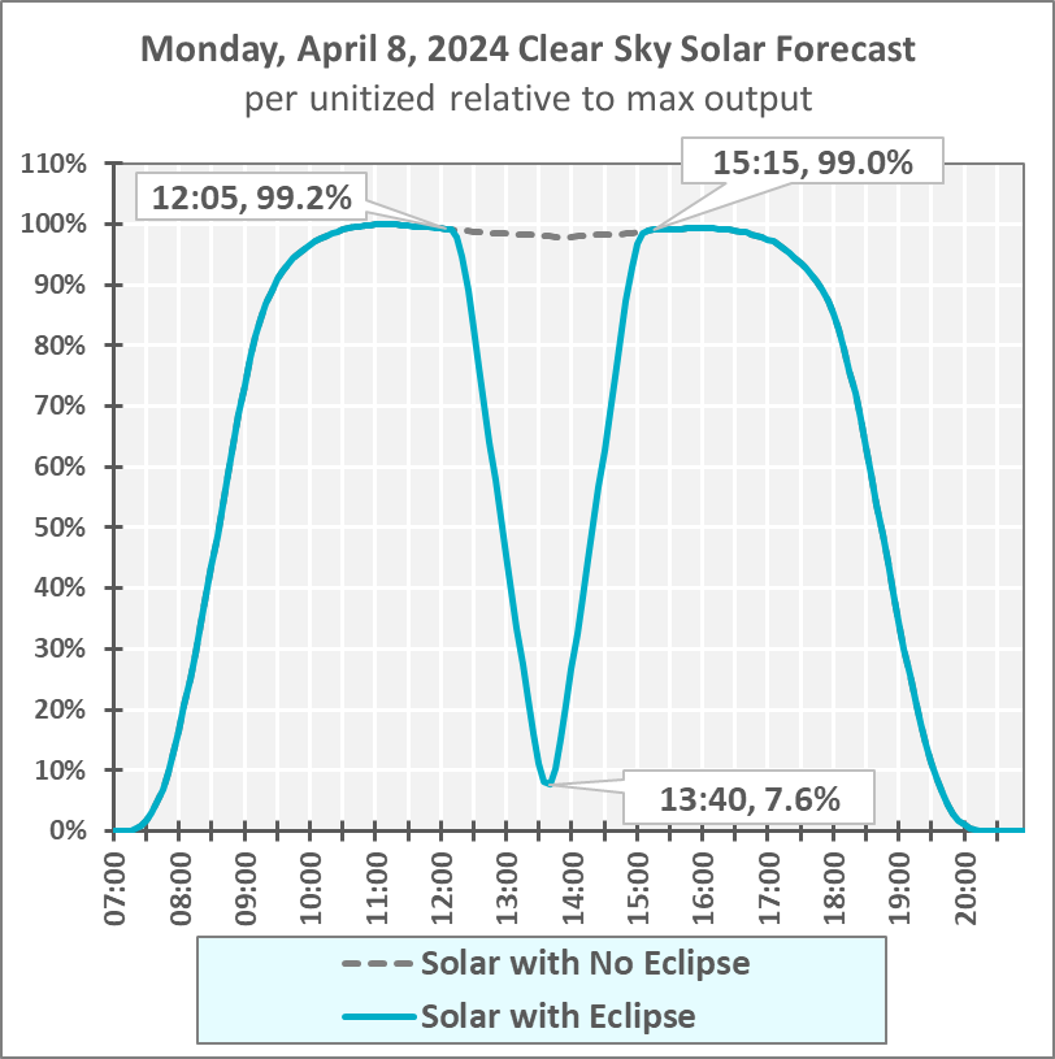Solar Eclipse Gives VPPs Chance to Shine

Credit: NASA’s Scientific Visualization Studio
A total solar eclipse will move across North America at more than 1,500 miles per hour on April 8. The moon will totally block the sun along the path in red.
Commercial and industrial energy users can look at the bright side of the upcoming total solar eclipse. They may generate additional revenue by making their distributed energy resources available to keep the lights on in their communities as virtual power plants.
Although grid operators’ extensive preparations should ensure that the grid has enough electricity to avoid capacity shortages during the eclipse on April 8, they may need to quickly bring on new sources of generation, like customer DERs as VPPs, when solar power dims.
Grid operators’ need to carry additional capacity could create opportunities for C&I energy users that make their DERs available through economic markets, reserves programs or other grid services via VPPs. Prices for grid services have the potential to spike, particularly if the weather is clear and solar generation is at or near its potential peak before the eclipse. The sharper the drop in supply that grid operators must cover, the greater the revenue opportunities may be for customers or the need for short term demand response events.
Grid operators as far west as California have been bracing for system challenges, even though the eclipse’s impact will be most acute along the 124-mile-wide path of totality that will slice a swath from Texas to Maine.
Intermittency Poses Challenge
The possible impact is much larger than the last time the moon totally obscured the sun, in August 2017. The amount of electricity generated from solar energy has tripled since 2017 with no signs of slowing. In fact, its share of total U.S. electricity generation could almost double over the next two years, rising to 7% in 2025 from 4% in 2023, according to U.S. Energy Information Administration projections.
Although solar generation is an increasingly popular clean energy source, its intermittency demands more grid flexibility, like for managing the California duck curve. State electricity charts typically show a midday decrease in demand when solar supply is highest followed by a spike in demand in the evening when solar supply plunges. Thus, a chart resembles a duck.
Grid flexibility will be especially vital during the upcoming total solar eclipse, which could cause up to six minutes of complete midday darkness in some parts of the country. In a worst-case scenario, solar power would completely cease for those six minutes after generating most of the grid’s electricity on a sunny day. On a chart, it would look like demand dropped from a cliff into a canyon.
Unless demand also drops to zero in that time, grid operators would need to quickly supply electricity from other sources to maintain balance. They would then have to decrease the supply from the new sources just as fast as the eclipse passes, and solar generation ramps up to its previous level. That is, solar generation or its equivalent would need to spring straight up out of the canyon. Hence, the need for flexible generation sources, like C&I customers’ DERs.
Grid Operators Look to Flexible Resources
Customer DERs like backup generators, battery storage or load curtailment are ideally suited to provide grid operators with the quick-ramping resources they want.
CAISO
California may be far from the path of totality, but the California Independent System Operator (CAISO) anticipates the eclipse impacting at least some of its 18,500 MW of installed grid-scale solar capacity and 15,770 MW of rooftop solar capacity, nonetheless.
Grid-scale solar generation will decrease by 6,349 MW from the start of the eclipse to maximum impact and increase by 6,718 MW after, according to a CAISO solar eclipse technical bulletin. The net load ramp rate will increase by an average of +115 MW per minute and then decrease by -150 MW per minute.
With a steep climb back to pre-eclipse levels, grid-scale solar resources will use special procedures to limit the solar generation ramp rate during the eclipse return. CAISO will also use battery and hydropower resources to help meet the system’s faster-ramping needs during the eclipse. It will also procure additional operating reserves to help with the expected change in solar generation.
ERCOT
Northwest Texas will be one of the first regions of the U.S. to experience a total eclipse on April 8 as it lies at the beginning of the path of totality. The Electric Reliability Council of Texas (ERCOT) estimates that the state’s solar generation will be impacted from 12:10 p.m. to 5:10 p.m. CDT.
The sun’s coverage of the moon will range from 81% to 99% with the brunt of the eclipse being felt around 1:40 p.m., when solar generation will drop to about 7.6% of its maximum clear sky output, according to an ERCOT resource forecasting and analysis.
ERCOT does not expect any grid reliability concerns during the eclipse because it has been proactively working on forecasting models to reflect reduced solar power production and preparing the grid accordingly. The grid operator says that it will be ready to meet both the down and up solar ramps and to use ancillary services for additional balancing needs.

ERCOT projects that solar generation could fall to 7.6% of its maximum clear sky output during the eclipse.
ISO-NE
ISO New England (ISO-NE) is collaborating with local utilities and neighboring grid operators to evaluate the expected conditions and potential impacts of the eclipse. All parts of New England will see at least 80% of the sun blocked by the moon during the peak of the eclipse, according to NASA.
ISO-NE says the eclipse could reduce solar energy production by thousands of megawatts. Most of the region’s solar power comes from small-scale, distributed systems connected directly to retail customers or local utilities and not the regional power system operated by the ISO, the grid operator notes.
“Though not anticipated, ISO system operators have a number of tools available to handle any supply deficits caused by extremely high demand or a sudden loss of other resources,” according to the ISO.
MISO
The Midcontinent Independent System Operator, Inc. (MISO) expects balancing and congestion management to be the biggest challenges, based on its experience with the last total solar eclipse in 2017 and a partial eclipse in 2023. MISO manages the flow of high-voltage electricity across 15 states, some of which lie in the path of totality for the upcoming eclipse.
For example, the following cities will experience total obscuration for the estimated durations, MISO notes.
-
- Indianapolis, Ind. – 3 minutes, 46 seconds
- Poplar Bluff, Ark. – 4 minutes, 8 seconds
- Little Rock, Ark. – 2 minutes, 33 seconds
- Mt Vernon, Ill. – 3 minutes, 40 seconds
MISO’s eclipse preparations include increasing regulation and short-term reserves and proactively communicating with its markets.
NYISO
The New York Independent System Operator (NYISO) forecasts a possible reduction of 3,000 MW or more in non-metered, or behind-the-meter (BTM)m generation solar generation at the peak of the eclipse, as well as a temporary loss of up to 110 MW in grid-connected, or front-of-the-meter (FTM), solar generation.
The eclipse is expected to be at its fullest from 3:16 p.m. to 3:29 p.m. EDT with 100% obscuration in Buffalo and Rochester for about 4 minutes apiece. Obscuration is to reach 96% in Albany. Across the state, the partial eclipse is to last about 2 hours and 30 minutes.
Actions to mitigate eclipse impacts could include manual operator intervention and supplemental commitment of fast-responding resources, according to NYISO. The grid operator is also running day ahead market simulations and refining BTM and FTM solar forecasts.
PJM
PJM’s eclipse plans include dispatching generation as needed to mitigate solar power losses, including reserve and regulation resources as required. Reserve resources can provide needed backup generation when called upon, while regulation resources can provide energy to help control voltage and frequency on the system, the grid operator notes.
Spanning all or parts of 13 states and the District of Columbia, PJM is preparing for the potential temporary loss of BTM and FTM solar resources during the eclipse. The actual amount of solar generation lost will depend on April 8’s weather. More solar power would be generated, and thus lost, on a sunny day than on a cloudy one, for example.
Even under cloudy skies, PJM is preparing to temporarily lose at least 80–85% of the production from its 8,200 MW of FTM, solar resources, as well as up to 4,800 MW of BTM generation.
VPPs Give Grid Flexibility
The eclipse could highlight how VPPs can help keep the grid balanced during extreme events. Aggregating customer DERs and dispatching them together offer fast, reliable and affordable ways to balance the grid. They also enable energy users with DERs enrolled as VPPs, such as C&I customers, to help the grid by flexing their loads as needed.
In the case of the eclipse, grid operators could cover temporary losses in solar power by tapping VPPs with customer DERs like load curtailment or distributed generation, instead of turning to fossil-fuel peaker plants that could cost more to use and emit more carbon dioxide.
The eclipse also emphasizes the importance of a well-rounded suite of energy assets that can help a C&I customer navigate a range of scenarios, rather than relying on a single type of resource like solar. For example, solar generation can be limited if snow prevents the sun from powering photovoltaic panels or if clouds obscure the sun. However, pairing solar power with battery storage could help a customer weather intermittency.
C&I customers should not limit themselves to using DERs for backup power either. VPP operators such as CPower can maximize the value of customer DERs by monetizing their abilities and optimizing their usage.
As the country’s leading DER Monetization and VPP provider, with 6.7 GW of DER capacity at more than 27,000 sites across the U.S., CPower helps customers earn grid services revenue and reduce energy costs by using their DERs to strengthen the grid when and where reliable, dispatchable resources are needed most.
In the days leading up to the total solar eclipse, CPower will help customers prepare their operations for resiliency while positioning them to earn money from grid services.
Call us at 844-276-9371 or visit CPowerEnergy.com/contact to explore how you can monetize your DERs and earn revenue for helping the grid.
Note: CPower would like everyone preparing for the eclipse to be safe, ensure you have proper solar eclipse sunglasses and to enjoy the show.
Visit the American Astronomical Society’s website for more safety information: How to View a Solar Eclipse Safely | Solar Eclipse Across America (aas.org).


